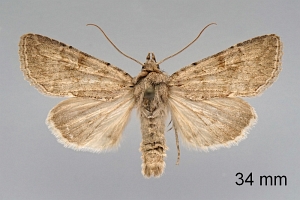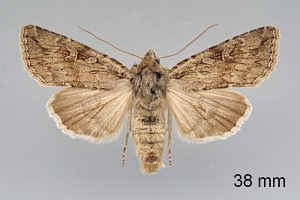Länder:

 +5Kontinente:EUAS
+5Kontinente:EUAS


 +5Kontinente:EUAS
+5Kontinente:EUASNeues Layout der Navigation (Beta Test)
2. Diagnose
2.1. Männchen
1: ♂, Kasachstan, Taldy Kurgan, Altyn Emel, 500 – 900 m, 13. Mai 1995 (fot.: Helmut Deutsch), leg. Lukhtanov, det. Toni MayrForum
2.2. Weibchen
1: ♀, Kasachstan, Taldy Kurgan, Altyn Emel, 500 – 900 m, 13. Mai 1995 (fot.: Helmut Deutsch), leg. Lukhtanov, det. Toni MayrForum
3. Weitere Informationen
3.1. Andere Kombinationen
- Pseudohadena stenoptera Boursin, 1970 [Originalkombination]
3.2. Faunistik
In Europa bisher nur von zwei Lokalitäten in Südostrussland (europäischer Teil) und dem westlichen Kasachstan bekannt (Fibiger & Hacker 2007). Savchuk & Kajgorodova (2020: 263) melden die Art erstmals von der Krim: "1♀, Судак, 4.5 км СВ пос. Солнечная Долина, ЮВ склон г. Кокуш-Кая, 320 м н.у.м., ксерофитные стации, ручной сбор ночью, 31.05.2018 (В.В. Савчук, Н.С. Кайгородова)."
Locus typicus nach Boursin (1970: 65): « rives du fleuve Emba (Uralsk), se jetant dans la mer Caspienne, au nord-est d'Astrakhan ».
3.3. Literatur
- Erstbeschreibung: Boursin, C. (1970): Description de 40 espèces nouvelles de Noctuidae Trifinae paléarctiques et de deux genres nouveaux des sous-familles Noctuinae et Amphipyrinae. 2e série. Contributions à l'étude des Noctuidae Trifinae, 166 (2). — Entomops 18: 45-79. Ex libris Jürgen Rodeland.
- Fibiger, M. & H. Hacker (2007): Noctuidae Europaeae. Volume 9. Amphipyrinae, Condicinae, Eriopinae, Xyleninae (part). — 410 S., 12 Farbtafeln; Sorø (Entomological Press).
- Савчук, B.B. & Н.С. Кайгородова (2020): Новые сведения по фауне и биологии чешуекрылых (Lepidoptera) Крыма. Часть II. — Кавказский энтомологический бюллетень, 16 (2): 255–264. [Savchuk, V.V. & N.S. Kajgorodova (2020): New data on the fauna and bionomics of Lepidoptera of Crimea. Part II. — Caucasian Entomological Bulletin, 16 (2): 255–264.]








